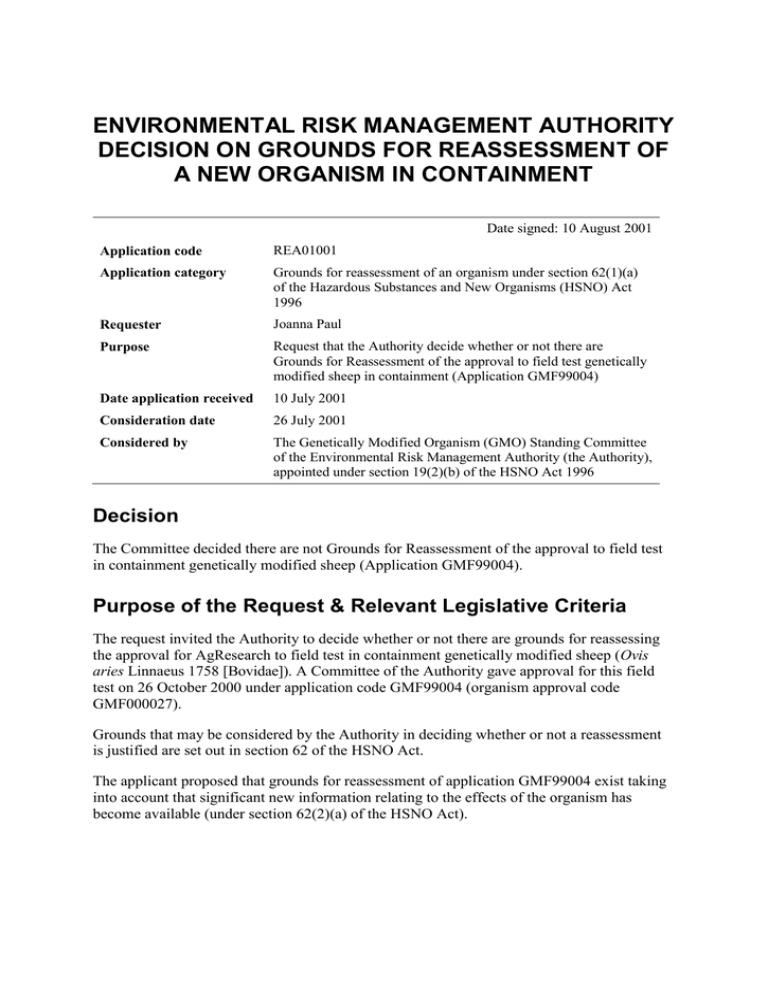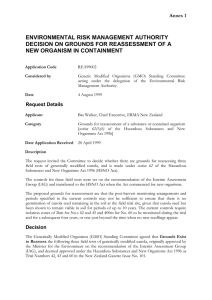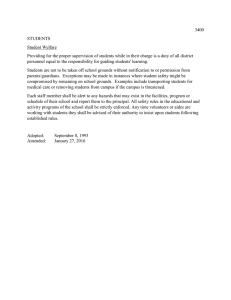ENVIRONMENTAL RISK MANAGEMENT AUTHORITY DECISION ON GROUNDS FOR REASSESSMENT OF A NEW ORGANISM IN CONTAINMENT
advertisement

ENVIRONMENTAL RISK MANAGEMENT AUTHORITY DECISION ON GROUNDS FOR REASSESSMENT OF A NEW ORGANISM IN CONTAINMENT Date signed: 10 August 2001 Application code REA01001 Application category Grounds for reassessment of an organism under section 62(1)(a) of the Hazardous Substances and New Organisms (HSNO) Act 1996 Requester Joanna Paul Purpose Request that the Authority decide whether or not there are Grounds for Reassessment of the approval to field test genetically modified sheep in containment (Application GMF99004) Date application received 10 July 2001 Consideration date 26 July 2001 Considered by The Genetically Modified Organism (GMO) Standing Committee of the Environmental Risk Management Authority (the Authority), appointed under section 19(2)(b) of the HSNO Act 1996 Decision The Committee decided there are not Grounds for Reassessment of the approval to field test in containment genetically modified sheep (Application GMF99004). Purpose of the Request & Relevant Legislative Criteria The request invited the Authority to decide whether or not there are grounds for reassessing the approval for AgResearch to field test in containment genetically modified sheep (Ovis aries Linnaeus 1758 [Bovidae]). A Committee of the Authority gave approval for this field test on 26 October 2000 under application code GMF99004 (organism approval code GMF000027). Grounds that may be considered by the Authority in deciding whether or not a reassessment is justified are set out in section 62 of the HSNO Act. The applicant proposed that grounds for reassessment of application GMF99004 exist taking into account that significant new information relating to the effects of the organism has become available (under section 62(2)(a) of the HSNO Act). Application Process Application receipt The application was formally received on 10 July 2001 under section 62(1)(a) of the HSNO Act 1996. The receipt of a request for Grounds for Reassessment of an organism approval is not required to be publicly notified. Information available for consideration The documents available for the consideration of the application included: Request and supporting information (received from applicant between 27 November 2000 and 28 May 2001). ERMA New Zealand staff evaluation of application REA01001, in a Memorandum to the Committee (dated 17 July 2001). Evaluation & Review (E&R) Report for application GMF99004. Decision for application GMF99004. The staff of ERMA New Zealand prepared an evaluation report to assist and support decision-making by the Committee. Potential effects were identified by reviewing the application and supporting information provided by the applicant. Joanna Paul was provided with a copy of the staff evaluation prior to the Committee's consideration. Her responses, while they reiterated her dissatisfaction with the decision, did not contribute grounds for its reassessment. Decision-Making Committee The application was considered by the GMO Standing Committee (the Committee) of the Environmental Risk Management Authority (the Authority) appointed in accordance with section 19(2)(b) of the HSNO Act. The Committee comprised the following members: Mrs Helen Hughes (Chair), Mrs Jill White, Professor Colin Mantell & Dr Oliver Sutherland. Consideration Meeting A consideration meeting was held on 26 July 2001. Evaluation In considering the request, the Committee took into account the information provided (as listed above). Principle issues raised in the request were: (i) horizontal gene transfer and potential consequential effects (ii) the possibility of unanticipated effects leading to disruption of otherwise normal biological connections, such as introduction of new proteins into an organism having the potential to result in new prion-like agents Environmental Risk Management Authority Decision: Application REA01001 Page 2 of 4 The Committee notes that these issues were considered at the public hearing on application GMF99004, as well as being discussed in the staff Evaluation & Review Report and the Decision for application GMF99004. These issues, including information provided by Dr Peter Wills on the potential for new prion-like agents to be formed, were also considered in earlier applications for field tests of genetically modified organisms It was noted in the decision for application GMF99004, that for the antibiotic resistance gene (or the disrupted sheep myostatin gene) to move to another organism a series of independent steps would be required. Based upon published scientific investigations, it was considered that the risk of horizontal gene transfer by these means was negligible. Overall, it was considered that the risk of the transfer of genetic material by other than reproductive mechanisms was negligible. The information supplied by Joanna Paul did not contain new information demonstrating that the potential for horizontal gene transfer from animals to bacteria differs from the assessment in the GMF99004 Evaluation & Review Report, or from information provided at the hearing. Potential for unanticipated adverse effects were discussed in the decision for application GMF99004. Based upon the site-specific genetic modification proposed, it was considered very unlikely that scrapie or prion-like agents would be associated in any way with the sheep or the genetic modifications. It was noted that even if prion-like agents were created they would be very unlikely to enter the human or animal food chain. Additionally, specific controls on disposal of animal material involved in the field test were provided. Any request to develop food products from myostatin-knockout sheep in the future would be subject to a separate application to ERMA New Zealand. Additionally, approval from the Australia New Zealand Food Authority (ANZFA) would be required before production of products for release could be undertaken. The Committee does not consider that the information provided in support of the request for grounds for reassessment provided any significant new information relating to unanticipated effects relevant to the approval for myostatin-knockout sheep. Section 62(2) of the HSNO Act sets out grounds that may be considered by the Authority in deciding whether or not a reassessment is justified. By implication (ie the use of the phrase ‘taking into account’), grounds other than those specified under section 62(2) may be considered as well. However, the Committee was not aware of any relevant information that fell outside the scope of these criteria that was relevant to this request. In summary, grounds for reassessing the decision, including containment controls, for application GMF99004 were not identified. The Committee concludes that the information provided in the request for grounds for reassessment does not represent significant new information relating to the effects of the genetically modified sheep. In reaching this conclusion, the Committee has taken particular account of the evaluation provided by staff. The Committee agrees with the conclusions listed in Appendix 1 of the staff evaluation, which specifies that information provided in the request is either not directly relevant to the consideration of effects for application GMF99004, or does not equate to 'new information' (ie the information has been assessed at, or prior to, the GMF99004 consideration). The Committee is confident that the decision for application GMF99004 adequately takes into account the possibility of unanticipated effects and horizontal gene transfer, and that adequate controls were provided with respect to these issues. Environmental Risk Management Authority Decision: Application REA01001 Page 3 of 4 It was unanimously decided that request for Grounds for Reassessment (REA01001) under section 62(1) of the HSNO Act be declined. _____________________ _______________ Mrs Helen Hughes, Chair Date Genetically Modified Organisms Standing Committee of the Authority Environmental Risk Management Authority Decision: Application REA01001 Page 4 of 4




![Request Form - Determine grounds for a reassessment [Word, 382 kb]](http://s2.studylib.net/store/data/015308384_1-9ccab5370cc41a336f7ce3d60dd25733-300x300.png)
